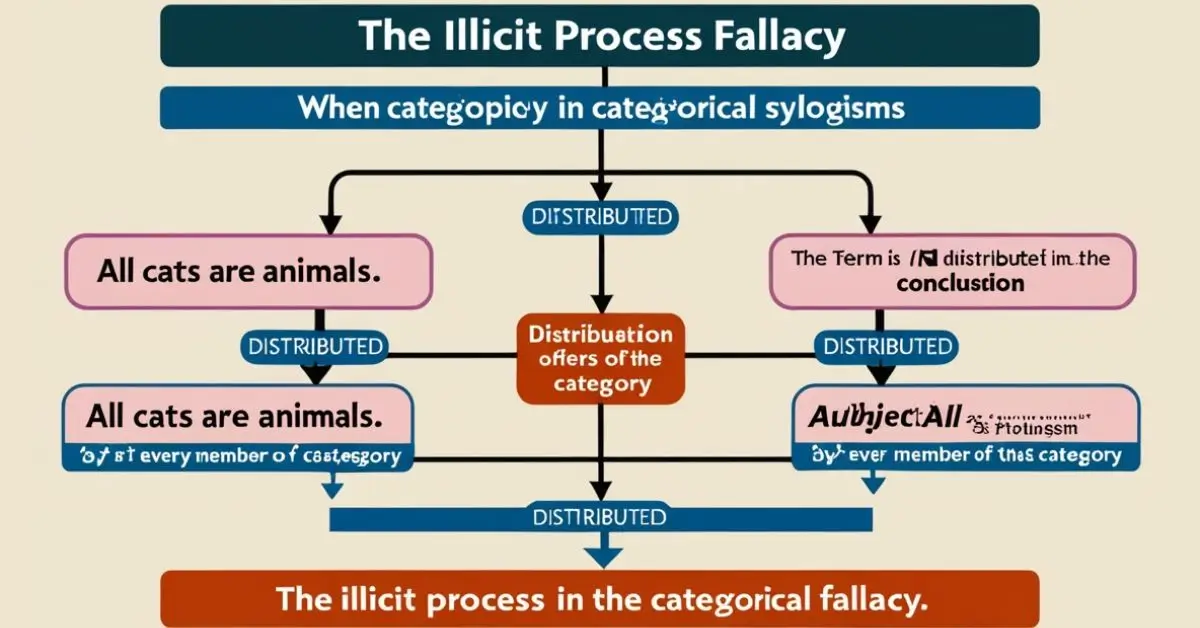Logical reasoning serves as the cornerstone of effective communication and decision-making. However, fallacies, such as the “illicit process,” can derail logical arguments, rendering them invalid. Understanding how to identify and address these fallacies is essential for both constructing strong arguments and critically evaluating others.
What Is an Illicit Process?
The illicit process fallacy occurs in categorical syllogisms when a term is improperly distributed. This happens when a term is undistributed in one premise but distributed in the conclusion, leading to an overgeneralization or invalid inference.
To clarify, a term is “distributed” when it applies to all members of a category. For example, in the statement “All cats are animals,” the subject “cats” is distributed because it refers to every member of that category. Problems arise when distribution rules are violated, as in the illicit process fallacy.
Types of Illicit Process Fallacies
1. Illicit Major
An illicit major occurs when the major term (the predicate of the conclusion) is undistributed in the major premise but distributed in the conclusion. This creates a false assumption about the entire group represented by the major term.
Example:
- All mammals are animals.
- No reptiles are mammals.
- Therefore, no reptiles are animals.
In this case, the major term “animals” is distributed in the conclusion (“no reptiles are animals”) but is undistributed in the premise. This leads to an incorrect inference.
2. Illicit Minor
An illicit minor happens when the minor term (the subject of the conclusion) is undistributed in the minor premise but distributed in the conclusion. This type of fallacy results in an overgeneralization about the minor term.
Example:
- All cats are animals.
- All cats are mammals.
- Therefore, all mammals are animals.
Here, the minor term “mammals” is distributed in the conclusion but not in the premise, resulting in a flawed argument.
How to Identify an Illicit Process
Detecting an illicit process requires careful analysis of the argument’s structure. Follow these steps to ensure logical consistency:
- Identify the Major, Minor, and Middle Terms
- The major term is the predicate of the conclusion.
- The minor term is the subject of the conclusion.
- The middle term links the premises together but does not appear in the conclusion.
- Check Term Distribution
Determine whether each term is distributed or undistributed in the premises and conclusion. - Assess the Logical Flow
Ensure the distribution of terms in the conclusion matches their distribution in the premises. A term distributed in the conclusion must also be distributed in its corresponding premise. - Validate Syllogistic Forms
Familiarize yourself with standard valid syllogistic structures to spot deviations.
Comparison Chart: Illicit Major vs. Illicit Minor
| Feature | Illicit Major | Illicit Minor |
|---|---|---|
| Definition | Major term distributed in the conclusion but not in the premise. | Minor term distributed in the conclusion but not in the premise. |
| Example | All dogs are animals. No cats are dogs. Therefore, no cats are animals. |
All birds are animals. All birds are warm-blooded. Therefore, all warm-blooded creatures are animals. |
| Error Type | Overgeneralization about the major term. | Overgeneralization about the minor term. |
| Detection Method | Check the distribution of the major term in both premises and conclusion. | Check the distribution of the minor term in both premises and conclusion. |
Why Do Illicit Processes Matter?
Recognizing illicit processes is critical for several reasons:
- Strengthening Reasoning Skills
Spotting fallacies enhances logical reasoning, improving decision-making and argumentation. - Promoting Constructive Debates
Identifying fallacies ensures discussions remain focused on valid points, fostering mutual understanding. - Enhancing Persuasion
Avoiding fallacies increases the credibility and impact of your arguments.
How to Avoid Illicit Processes
To prevent this fallacy:
- Ensure Proper Distribution: Check that any term distributed in the conclusion is also distributed in the premises.
- Review Syllogistic Rules: Familiarize yourself with valid forms of categorical syllogisms to maintain logical consistency.
- Practice Analyzing Arguments: Regularly evaluate arguments to build familiarity with common fallacies.
Practical Example: Analyzing an Argument
Consider the following argument:
- All athletes are disciplined individuals.
- All disciplined individuals are successful.
- Therefore, all successful individuals are athletes.
Analysis:
- Major term: Successful individuals.
- Minor term: Athletes.
- Middle term: Disciplined individuals.
The conclusion improperly distributes the major term (“successful individuals”) without it being distributed in the corresponding premise. Thus, this argument commits an illicit process fallacy.
Building Logical Resilience
Learning to identify and avoid illicit processes equips you with tools for logical resilience. By understanding these fallacies, you can construct stronger arguments and critically assess others’ reasoning, fostering clear and effective communication in any context.
For further clarity, visual aids such as charts or videos explaining categorical syllogisms can provide deeper insights. A clear understanding of these principles ensures your reasoning remains free of logical errors, promoting better decision-making and more compelling arguments.












